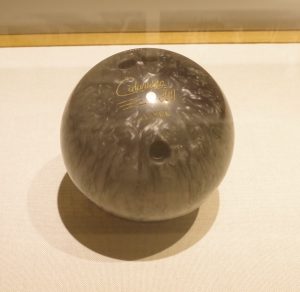Bowling Ball Courtesy of Kathy Smith
Photo Courtesy of Ken Aschliman
Historically, most bowling balls were made of Lignum vitae, a very hard wood. In 1905, the first bowling ball with a hard rubber outer shell was produced. In the 1980s, urethane-covered bowling balls became the standard. The cores used in present-day bowling balls may be hard rubber; a mixture of hard rubber, cork, and wood flour; wood chips; sawdust; or shavings mixed with inorganic fibers and held together with a binder (such as phenol formaldehyde, epoxy resins, polyester resins, melamine, or urea-formaldehyde).
Maple has been the material of choice for bowling pin cores for well over 200 years. As mandated by the American Bowling Congress and the Women’s International Bowling Congress, all bowling pins are made “of new (unused), sound, hard maple.” Originally, the pins were made out of a single block of hard maple, but this made them more difficult to standardize. Gluing together several pieces of wood gives the compression-resistant advantage of presenting all edge grain to the outside of the pin. Because no one layer runs all the way through the pin, it is less prone to splitting and easier to standardize. While other materials have been explored, the distinctive sound of wooden pins crashing is part of the aura of the game, and no other material can match it.

